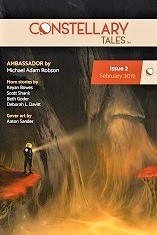 Constellary Tales #2, February 2019
Constellary Tales #2, February 2019
“Ambassador” by Michael Adam Robson
Reviewed by Jason McGregor
This second issue of Constellary Tales is my first exposure to it. It presents a mix of fantasy and science fiction in five stories which range from 1000-3300 words and seems to have potential.
“Ambassador” by Michael Adam Robson
Under a swampy world, a parasitic fungus hive mind has a couple of enemies and has split to fight them. Now, the personalities of Sil and Isil have turned against each other to fight for dominance, rekindling the initial wars, as well. When strange creatures with isolated minds arrive, Sil wonders if they can be used to tilt the balance in her favor.
The parts of this are familiar and the story walks the fine line between efficient and insufficient (especially regarding the generic “combat”) but it created an interesting atmosphere. The shifts of plot expectations and perspective at the end were very effective.
“A Scent of Roses” by Keyan Bowes
In this fairy tale of sorts, Rose is a seventh son born into a matriarchy where boys are less highly regarded than girls. Worse, he has pink skin and white hair instead of brown skin and black hair. So the grandfather euthanizes him, suffers under a curse, and finally tries to make things right.
The grandfather would seem to be either evil or acting within his society’s boundaries but is handled as though he were someone between and his eventual effort at righteousness is not enlightened or enlightening.
“Para Bellum” by Scott Shank
When an interstellar intruder from an evil empire enters a solar system through a wormhole, the protagonist intercepts her and quarantines her, but she’s powerful and a battle for control of the interceptor vessel ensues.
Though this has a cyclical structure, it reads like an excerpt from a larger work in which the characters and sides would be better defined but it’s at least full of action.
“Streetlight Discovers Kandinsky” by Beth Goder
An artist influenced by Kandinsky does her drawings under an AI streetlight until they make contact.
While aspects of the art and connection are good, a couple of the things which hurt this metafictional (or meta-artistic) tale are its pseudo-technological magic and, as short as it is, its excessive length for what it is.
“The Archmage’s Invitation” by Deborah L. Davitt
In the one 1,000-word story, an archmage invites a magic-less lady aboard his magic ship to offer her a deal that is both economically and socially unusual.
This is so slight that it makes little impact one way or the other, though it does have extraneous parts (like the sister).
More of Jason McGregor’s reviews can be found at Featured Futures.